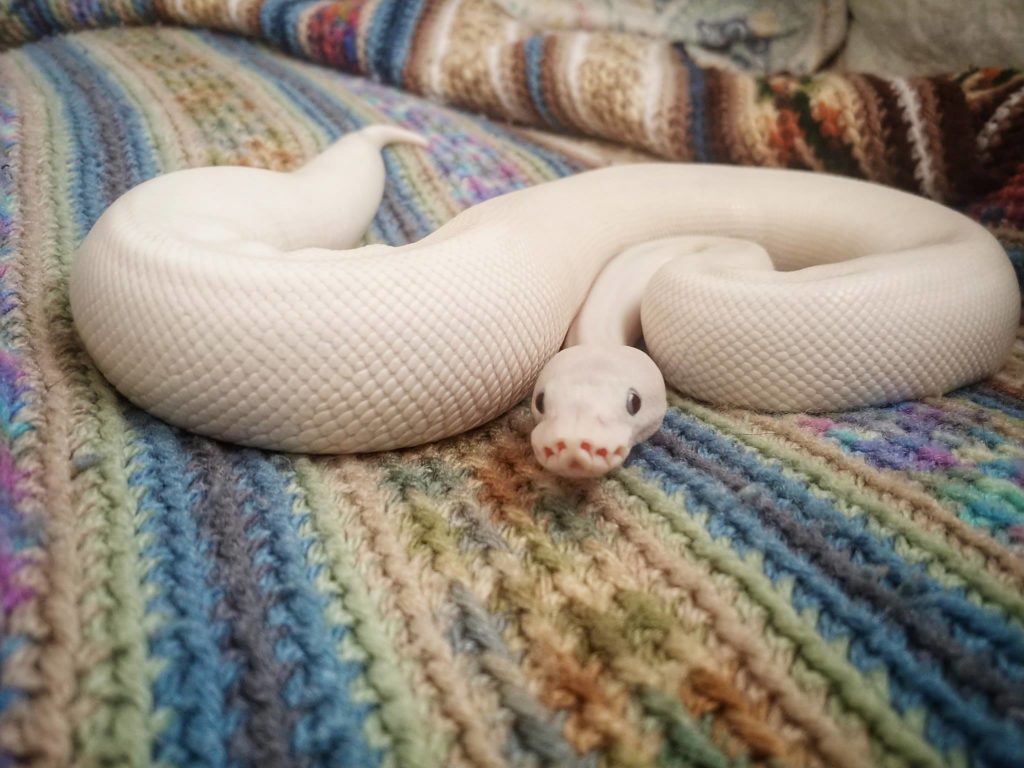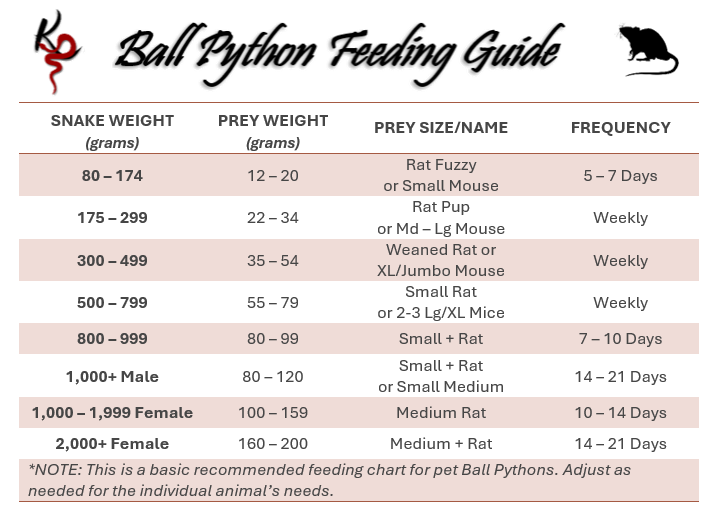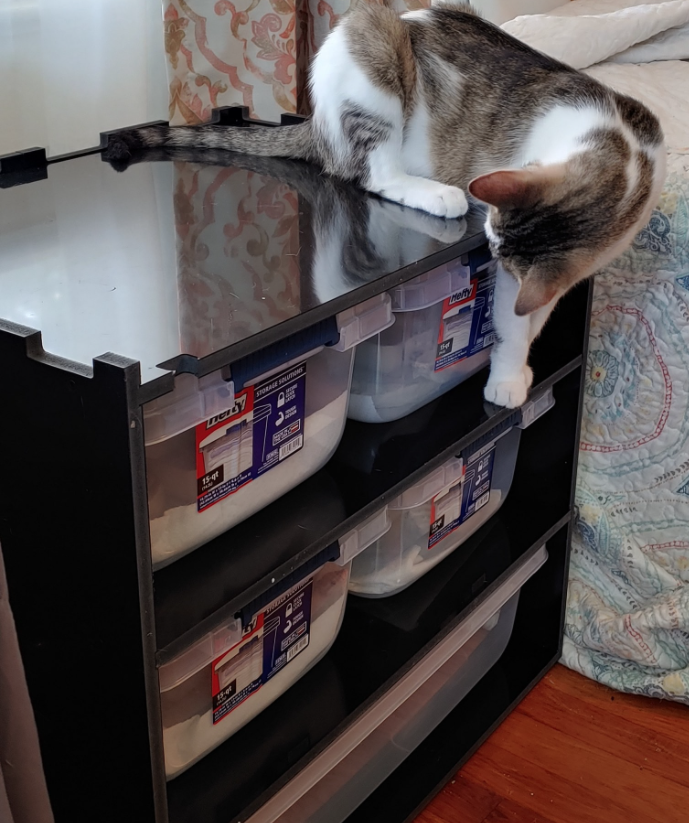Ball Pythons – Care & Feeding Guide

In this guide, you will find information About Ball Pythons as well as on Feeding, Housing, and Troubleshooting Ball Python care. Use the bolded links to jump to each section, though it is recommended that you read the entire article.
QUICK LINKS
Download a PRINTABLE CARE GUIDE by clicking the link. (PDF)
Download a PRINTABLE TANK SETUP GUIDE and PRINTABLE Shopping List if you will be using a glass tank. (PDF)
Check out the Quarantine Guide on safely bringing home a new pet.
Humidity or Heat trouble? Read THIS POST on maintaining your pet’s enclosure.
Read up on the Benefits of Feed Frozen Prey with tips on transitioning your pet.
Pet on a hunger strike? Check out the post on Why is My Snake Not Eating?
About Ball Pythons
Ball Pythons (Python regius) are one of the most commonly kept pet snakes. They are usually calm and they don’t get very large, making them a great choice for a pet.
ORIGINS: Ball Pythons are a terrestrial species of python found in regions of western and central Africa. In the wild, they are most often found in semi-arid grasslands, forests, and near agricultural areas. They prefer to live in burrows, termite mounds, and low vegetation, most often hunting on or near the ground. They are crepuscular in nature, which means that these snakes are most active around dawn and dusk, as well as at night. As ambush hunters, they actively track down and then wait for prey such as rodents to run past before striking. They are opportunistic hunters, so fallen or injured small birds and even lizards are fair game in the wild. Young snakes or smaller slender males may even climb up to low bird nests to grab an easy meal during hatching season. (NO, this does not make them semi-arboreal.)
SIZE: Ball Pythons are sexually dimorphic. That means there is a noticeable difference between males and females. In this case, only as adults. Adult females are noticeably thicker in body mass and reach sizes of 3.5 to 4.5′ regularly, though females can reach sizes over 5′. Males are more slender and tend to top out between 3 to 4′ in length.
LIFESPAN: Ball Pythons reach sexual maturity at 18 months to 2 years for males and 2.5 to 4 years old for females. Typically, they will reach adult size around 4-7 years old. Most pet snakes will live a lot longer than you might think. Ball pythons have an average lifespan between 15 to 30 years if well taken care of. The oldest Ball in our current collection was born in 2004.
BEHAVIOR: Ball Pythons are medium-sized, shy snakes. They get their name from their tendency to ball up when they feel threatened. They are curious explorers when comfortable with their surroundings, though they are known to pick a favorite spot and sit for hours or even days. This spot could be a favorite hide, under the heat source, in their water, or around their owner’s neck. Being crepuscular, they sleep most of the day and will venture out to explore in the evenings or at night.
FEEDING
First and foremost, your young BP should be started on rats as soon as possible. Many breeders will start their hatchlings on rat pinkies or fuzzies from the first feeding to avoid any pickiness issues. Ball Pythons can be picky about their prey and feeding them mice can often lead to them refusing other prey items. This isn’t an issue until your snake is near adult size and a single mouse is no longer enough food for them.
First and foremost, NEVER move your pet to feed them. It is, unfortunately, still recommended by some to move your snake to a separate feeding tub or tank to “reduce cage aggression.” This is a myth. Moving to feed was a commonly recommended practice back in the 1980s. We have learned just a wee bit since then and this myth has been busted time and time again. Feed your snake in its enclosure where they feel safest. Moving to feed opens you up to getting bit and it can cause stress for your pet, even regurgitation.
Feeding schedule: You should feed baby BPs, less than 4 months old, every 5-7 days. Juvenile snakes should be fed weekly or every 10 days. Sub-Adult and Adult size snakes should be fed every 10-21 days depending on prey size and size of your snake.
Feeding sizes: For babies or young snakes, it is helpful to use a digital kitchen scale to weigh your snake and your snake’s food. Weigh your snake monthly to track gain, preferably “empty” before feeding and after a good poo. A growing BP should be eating a single prey item that is between 10 and 15% of their body weight, or a bit larger. If your baby BP weighs 100 grams, then you want their food to weigh 10-15 grams, which would be a fuzzy rat.
Once your snake gets to be sub-adult size, 7-10% of their body weight is plenty and you can feed less often. So if your 2 yr old male BP weighs 700 grams, he should be getting a 50-70-gram meal, which is a small rat, every 7-14 days.
Adult BPs should be fed a meal that keeps them at a healthy weight. Big females over 1500 grams should get medium rats (120-180 grams). Males are usually fine on small rats or small/medium sizes (50-100 grams). You’re trying to maintain their size, not gain at this point. Most adults will maintain their weight by being fed every 2 weeks, or even every 3 weeks. If you prefer to feed more often, offer smaller prey to avoid obesity. Fat snakes can have health problems or are more prone to illness.

HOUSING
Being shy, crepuscular smaller snakes, Ball Pythons prefer dark, quiet places where they feel safe from predators and exposure. Originating from Sub-Saharan Africa, they need warmer temps (85-89 degrees on the warm side) and moderate humidity (55-70%). Your cool side should not dip below 75 degrees even at night. All of this means the glass tank snake kit you bought at the pet store is not ideal.
At KP, we recommend keeping your Ball Python in a PVC (or well-sealed wood) snake enclosure or a rack system. Both are much easier to maintain steady temps and humidity. They also take up less room, are lightweight, and are easier to clean. PVC enclosures can be stacked right on top of each other so you have room for more snakes!
If you have just one or two snakes, want to give your snake(s) a more enriching environment, or prefer to have a nice setup to display in your home, a PVC enclosure is a great option. Larger adult snakes will need a 4×2 size PVC enclosure. Just add plenty of hides and clutter for smaller animals. An enclosure that is 12″ tall is more than adequate for this terrestrial species, though a cage that is 15″ or 18″ tall will give you some room to decorate or add live plants. Taller cages are more difficult to maintain proper temperatures at ground level, often resulting in snakes attempting to climb to find a warmer spot to rest. We do not recommend a 2′ tall or taller cage for ball pythons.

If you have a larger collection of varying sizes of animals a combo rack is a great investment. It holds different size tubs to allow you to house most of your ball pythons in the same rack and increase tub size as your baby grows.
Or if you prefer your snakes to have more room, the tubs for this roomy 45 qt 70-series adult breeding rack will be comfortable for even the largest females. Add a couple of hides for smaller snakes to feel safe and secure. These units are stackable and come in a three tub size if you don’t need room for 5 snakes.
There are other sellers of PVC enclosures and racks if you want to shop around. Toad Ranch and Focus Cubed Habitats have some good ones, as do Vision, TGR, and Brace Exotics. Just be sure you get the right heat and thermostat that the manufacturer recommends.
HEATING: You may have purchased or been recommended a heat mat/pad or under-tank heater. These are fine for creating a warm spot for your snake to sit upon, but they do very little to heat up the ambient temperatures in most enclosures. Unless your room stays around 80-82 degrees year-round, you will need more than just the UTH heat source. A radiant heat panel is the best option for PVC or similar solid enclosures. A dome lamp with a ceramic heat emitter or deep heat projector is recommended for enclosures with a screen top or cutout. Racks are usually fine with just the heat tape that comes with them.
All heat sources should be used with a thermostat to keep temps steady and prevent burns or overheating, even heat mats that claim to stay at reptile-safe temperatures. We recommend a Herpstat 1 or VE-200 as they are dimming/proportional and keep temps very even. There are several budget-friendly thermostats available as well. Zarco or BN-Link (heating) thermostats from Amazon are good alternatives. They are affordable and will last about a year before you should replace them (even if it’s still working). In an open enclosure, place your probe on the hot side a couple of inches above the substrate and set it to 87 degrees. Use an infrared temp gun to make sure the surface temps under your heat source are no hotter than 93 degrees. Adjust the thermostat as needed. In a rack or when using heat tape or mats, use electrical tape or similar to place your thermostat probe on the heat tape itself. In a rack, be sure it’s in a spot where the tubs won’t dislodge the probe when opened and closed. Do not use foil tape as it can interfere with the readings.
Throw away those dial temp/humidity gauges that you bought at the pet store. They are wildly inaccurate. You want a digital thermometer, preferably one that does both temperature and humidity. Most pet or reptile stores will have them. You can also find small box units for home use in stores like Walmart. An infrared temp gun is also a must-have to check surface temps. Any home supply or repair store will have them. When you measure temps, just be sure you’re not going through glass or acrylic doors. You need no barriers between the heat gun and what you’re trying to measure.
HUMIDITY & SUBSTRATE: Humidity is VERY important for the health of your Ball Python. Most homes in the USA have humidity lower than 50%, especially if you’re running heat or air conditioning. Add to that the higher temp requirements for your snake, and you’re going to have even lower humidity in your enclosure. To maintain the 55-70% range, we recommend using coco husk or cypress substrate; a thick 3-5″ layer is best for humidity. The chunky coco chips are much more suitable than the fine dirt-like coco coir/fiber. Pro Coco is our preferred brand here at KP. CocoBlox by Freedom Breeder and Reptichip are the two other major brands that are recommended by many breeders. When first using coco husk, add a minimal amount of water to it before or after you put it in your enclosure. Mix it up well so the dampness is evenly distributed. Watch your humidity levels for a few days. If they stay within range, great! If they fall quickly, add some more water. If they are too high, remove some of the damp bedding and replace it with dry bedding. Spot clean the enclosure as needed and pour water in to rehydrate it. DO NOT MIST your enclosure to bring up humidity. Misting just dampens the top layer, so your humidity spikes too high and then dries quickly, which is stressful on your snake’s lung. It’s better to use a cup poured directly into the bedding so it goes to the bottom layer and is absorbed naturally.
*NOTE: When your snake is in blue, that is, he is about to shed, it’s a good idea to make sure the humidity is on the high end of the range. Adding some extra water to your substrate, especially to the warm side of the enclosure, will help ensure your snake has an easy shed and it all comes off in one piece.
HIDES: In an open enclosure, you need hides, one on the hot side and one on the cool side at the very least. We prefer plastic hides as they are easily cleaned. Those half-log wood hides are just bacteria and mold factories and not “hidey” enough for your BP to be super happy. Additional clutter in the way of fake plants and cork flats are also useful to help your snake feel more at home. Just be sure there are no openings or loops that your snake can crawl through and get stuck, as well as no sharp edges.
LIGHTING: Ball pythons do not require UVB and they do not often bask in nature unless they are particularly cold. Ambient room lighting from a window is generally enough to give your snake a day/night cycle even in a rack set-up. In an enclosure, adding LED or UVB lighting is fine for aesthetics or if you have living plants. Some people prefer to give their snakes the option to access UVB light as they would have in nature. You want the light to be dim, between 3-7% UVB rating, and on a timer for no more than 6-12 hours a day. Adding additional fake plants or clutter is necessary to make your snake feel more secure while having a lit enclosure. Just be sure to replace your UVB bulbs every 6-12 months as the UV coating wears off and provides no benefit when it does.
If your snake has enough hides and your husbandry is spot-on, he will spend 90% of his life hiding. If your young BP roams the enclosure daily or climbs a lot, then he’s likely stressed and unhappy with his environment. A happy BP is a hidey BP!
If you must keep your glass tank, CLICK HERE for tips to make your Ball happier in it. Or check out this PDF tank setup guide that can be printed or saved to your phone.
TROUBLESHOOTING
If your snake isn’t eating regularly, sheds come off in pieces, or he’s roaming a lot, here are some things to consider.
Check your temps. Low temps will lead to poor digestion and lack of appetite. Even if your temps are good, try bumping them up a degree or two if your hot side is in the mid-80s, or reducing them if they’re closer to 90 degrees.
Check your humidity. You should not mist your snake enclosure! If you’re having to mist, then your enclosure is not ideal. Try using pure cypress or coco chips as your substrate to bump up humidity. Get a bigger water bowl and put it closer to the hot side. Plug up any holes in the screen lid.
Roaming snake: More hides, blackout more of the glass, check temps, or try putting him in a smaller enclosure or blocking off a portion of your current enclosure. Move your snake to a quieter room with less traffic or activity. Turn down your stereo. Snakes are sensitive to vibrations so loud music or a lot of bass can make them nervous.
Adult BPs can get restless and go off feed during the breeding season, which is usually late winter to early summer. This happens more commonly if you have mature snakes of both sexes in the same room. We have only experienced this with a small percentage of snakes, which makes me feel like it is not as common as people would like to think. If your snake is young, less than 1000 grams or 2 years old, then this does not apply at all.

